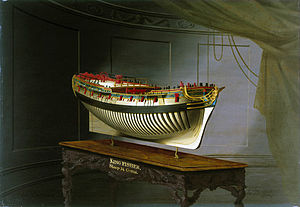 Painting by Joseph Marshall (1773–1775) of Kingfisher hull model
| |
| History | |
|---|---|
| Name | HMS Kingfisher |
| Ordered | 18 January 1766 |
| Builder |
|
| Laid down | January 1769 |
| Launched | 13 July 1770 |
| Completed | 21 November 1770 |
| Commissioned | September 1770 |
| Fate | Burnt to avoid capture at Newport, Rhode Island, 7 August 1778 |
| General characteristics | |
| Class and type | Swan-class ship sloop |
| Tons burthen | 302 8⁄94 bm |
| Length |
|
| Beam | 26 ft 10 in (8.2 m) |
| Depth of hold | 12 ft 10 in (3.91 m) |
| Complement | 125 |
| Armament | 14 × 6-pounder guns |
HMS Kingfisher (also spelled King's Fisher or Kingsfisher) was the second ship in the 14-gun Swan class of ship sloops, to which design 25 vessels were built in the 1760s and 1770s. She was launched on 13 July 1770 at Chatham Dockyard, and completed there on 21 November 1770. She took part in the American Revolutionary War, enforcing the blockade of the Delaware Bay, and served in the Battle of Turtle Gut Inlet, near Cape May, New Jersey. While under the temporary command of Lieutenant Hugh Christian, she was burnt by her own crew to avoid capture on 7 August 1778 in Narragansett Bay during the Battle of Rhode Island.[1]
- ^ "British Unrated ship-sloop 'Kingfisher' (1770)". Three Decks – Warships in the Age of Sail.